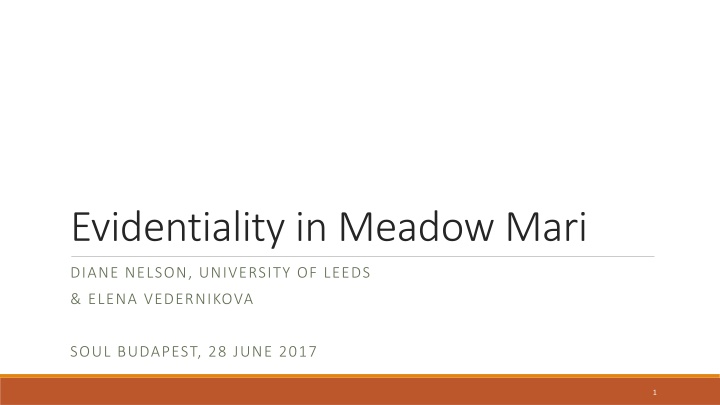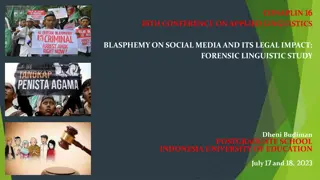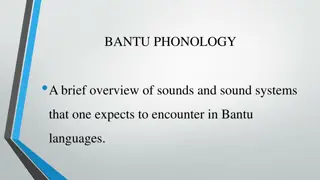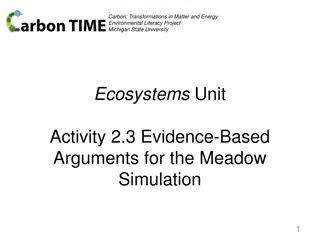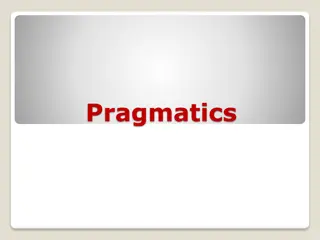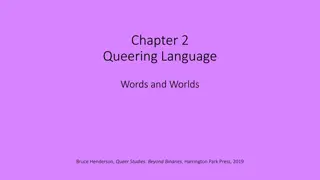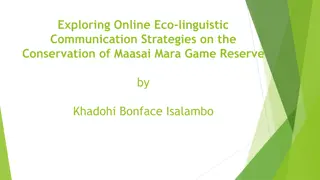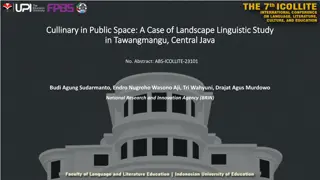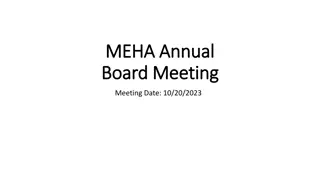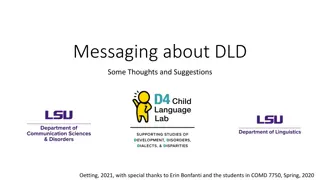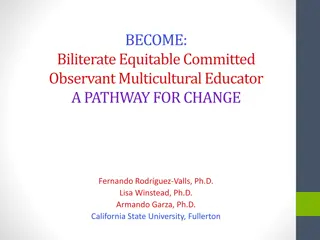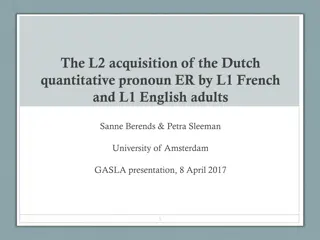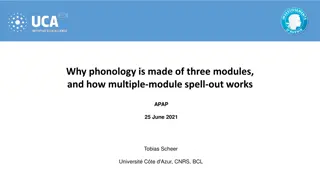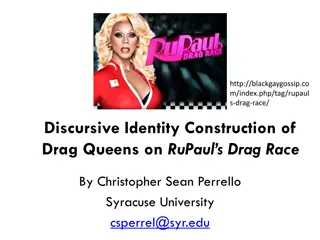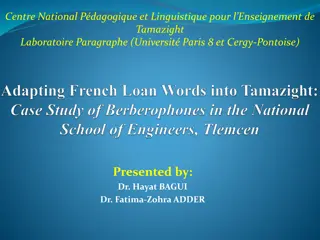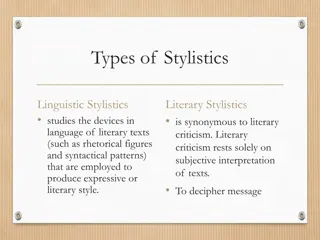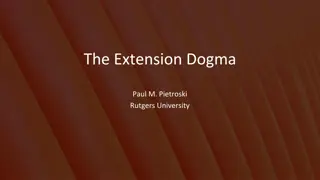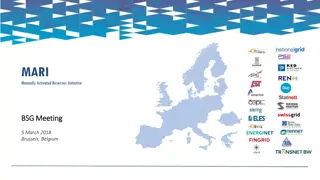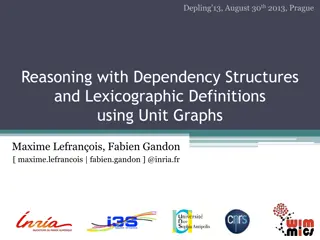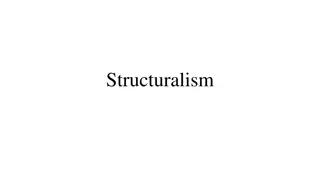Evidentiality in Meadow Mari: A Linguistic Study
This presentation discusses evidentiality, mirativity, and tense in Meadow Mari, focusing on sensory perception and embedded clauses. Meadow Mari, a Uralic language, has unique tenses and grammatical features influenced by extensive Turkic contact. The study analyzes past tenses, compound tenses, auxiliary verbs, and conjugation patterns in Meadow Mari. Insights from a questionnaire study provide valuable linguistic data for understanding the language's structure and usage.
Download Presentation

Please find below an Image/Link to download the presentation.
The content on the website is provided AS IS for your information and personal use only. It may not be sold, licensed, or shared on other websites without obtaining consent from the author.If you encounter any issues during the download, it is possible that the publisher has removed the file from their server.
You are allowed to download the files provided on this website for personal or commercial use, subject to the condition that they are used lawfully. All files are the property of their respective owners.
The content on the website is provided AS IS for your information and personal use only. It may not be sold, licensed, or shared on other websites without obtaining consent from the author.
E N D
Presentation Transcript
Evidentiality in Meadow Mari DIANE NELSON, UNIVERSITY OF LEEDS & ELENA VEDERNIKOVA SOUL BUDAPEST, 28 JUNE 2017 1
Overview of the talk 1. Introduction 2. An overview of Meadow Mari tenses; evidentiality, mirativity and TAM 3. Some predictions 4. Results of questionnaire study 5. Sensory perception licensing direct evidential 6. Embedded clauses and scope effects 2
Mari Mari belongs to the Volgaic branch of Uralic (with Mordva) Main dialects, Meadow and Hill are mutually intelligible. Most speakers are bilingual Mari and Russian speakers Extensive contact with Turkic Meadow Mari has about 414,000 speakers 3
TAM in Meadow Mari Mood: Indicative, Imperative, Desiderative Present (nonpast) tense Simple Past 1 & 2 Compound tenses 4
Two Past Tenses PAST TENSE 1 PAST TENSE 2 From proto-Uralic * i- and *-sj- Derived from gerund plus copula ulam is (realised as zero in 3s) Conj 1: tol-yn-am come.PST2-1s I came tolj-y-m come-PST1-1s I came Conj 1: Conj 2: voz-en-am write-PST2-1s I wrote Conj 2: vozy- -ym write-PST1-1s I wrote 5
Past Tenses Simple past tense 1 Simple past tense 2 Past Perfect 1 Past perfect 2 Compound past 1 (imperfective) Compound past 2 (imperfective) Suffixes Simple past 2+ ylje Simple past 2 + ulma Present tense + ylje Present ulma tense + tol-yn-am ylje 'I had come' tol-am ylje 'I was coming' Conjugation 1 -y tolj-y-m 'I came/ have come' -yn tol-yn-am 'I came' tol-yn-am ulma 'I had come/ I appeared to have come' tol-am ulma 'I was coming' voz-en-am ylje 'I had written' voz-em ylje 'I was writing' Conjugation 2 - -en voz-en-am I wrote' voz-en-am ulma 'I had written/ I appeared to have written' voz-em ulma 'I was writing' Vozy- -ym I wrote/ have written' 6
Auxiliaries in Compound Tenses WITH PAST TENSE 2: ulma WITH PAST TENSE 1: ylje Traditional Mari grammars: auxiliary Traditional Mari grammars: auxiliary Riese et al 2017: particle Riese et al 2017: particle Uninflected Uninflected Derivation unclear- fromula to be ; possibly ul+Turkic -ma from ula to be PAST1.3S Traditional grammars: Past 1 forms associated with direct evidentiality (speaker witness) Traditional grammars: Past 2 forms associated with indirect evidentiality (inference, hearsay) 7
Past Tenses Simple past tense 1 Simple past tense 2 Past Perfect 1 Past perfect 2 Compound past 1 (imperfective) Compound past 2 (imperfective) Simple past 2+ ylje Present tense + ylje Suffixes Simple past 2 + ulma Present tense+ ulma tol-yn-am ylje 'I had come' tol-am ylje I was coming' -y tolj-y-m 'I came / I have come -yn tol-yn-am 'I came' tol-yn-am ulma 'I had come/ I appeared to have come' tol-am ulma 'I was coming' direct evidentiality indirect evidentiality direct evidentiality indirect evidentiality direct evidentiality indirectevidentiality but evidentiality doesn t correlate in a straightforward way with morphology. 8
Evidentiality Brugman & Macaulay (2015) Evidentiality can be reduced to 2 core components: 1. Marks source of evidence (e.g. direct perception vs inference/hearsay) 2. Membership in grammatical systems All other properties are subject to cross-linguistic variation 9
Evidentiality Cross-linguistic variation (Aikhenvald 2004, Brugman & Macaulay 2015): Mirative and TAM semantics Locus (lexis, tense/mood or complementisers) Nature and type of sensory perception to license evidentials Scope and subordination The values of these variable properties cannot be assumed but must be empirically determined for individual items and languages. Brugman & Macaulay (2015:1) 10
TAM and evidentiality Perfect of evidentiality c. Turkish Gel-mi -im. come-PERF-1SG Cross-linguistic correlation between morphological encoding of present perfect aspect (PPA) and indirect evidentiality (Bybee & Dahl 1989, Izvorski 1997): It is said that I have come. I infer that I have come (1) a. Bulgarian Az sam dosal. I be-1SG.PRES come-P.PART (Izvorski 1997:1) b. Norwegian Jeg har kommet. I have-SG.PRES come-P.PART 11
TAM and evidentiality The evidential uses of perfects develop because the perfect is used to describe past actions or events with present results. If the focus of the meaning is on the idea that the present results are connected to and perhaps attest to past actions or events, then the notion of an action known by its results can be extended to actions known by other indirect means, such as by inference (from reasoning in addition to inference from results) and by reports from other parties. Bybee & Dahl (1989:73-74) 12
TAM and evidentiality Izvorski (1997) formalises the link between semantics of present perfect with semantics of indirect evidentials Indirect evidentiality is a propositional operator Ev, which is an epistemic modal Present perfect and indirect evidentials share core semantics: for PPA, the consequent state of the core eventuality holds at TU. for Ev, the core eventuality does not hold at TU; the speaker knows that proposition p has consequences or results, and has indirect evidence of p Present perfect morphology contributes either to the temporal interpretation of propositions or to their evidential status (Izvorski 1997:235) 13
The perfect of evidentiality in Turkish (2) a. O gel-di. > Turkish definite past /-ti, -di/ s/he arrive-PAST S/he arrived (direct evidential) > Indefinite past /-mi / Derived from and identical to gerund Occurs in compound tenses Only present perfect has evidential meaning Pluperfect gel-mi -ti s/he had arrived # s/he apparently had arrived Izvorski s analysis of PPA extends to morphology derived from present perfect b. O gel-mi . s/he arrive-PERF(PAST2) S/he (apparently) arrived (indirect evidential) 14
Mari Past Tenses (again) PAST TENSE 1 PAST TENSE 2 From proto-Uralic * i- and *-sj- Derived from gerund tolj-y-m come.PST1-1s I came Conj 1: Conj 1: tol-yn-am come.PST2-1s I came Conj 2: voz-y- -y-m write-PST1-1s I wrote Conj 2: voz-en-am write-PST2-1s I wrote cf elsewhere in Uralic, Mongolian etc. 15
Does Mari have a Present Perfect? > Prediction: Mari PAST2 should encode PPA semantics and indirect evidential operator Ev 4 versions of present perfect (Ritz 2012): 1. The perfect of persistent situation , which describes a state holding during a specific period including the present moment, as in Mary has lived in Leeds for 20 years (and still lives there) 2. The existential perfect, which means the event has happened at least once up until the moment of speech, as in Mary has eaten worms. 3. The perfect of result, which means that the result or consequences of an event hold at the moment of speech, as in Mary has arrived (and is still here) 4. The hot news perfect, as in Mary has (just) told me she s moving to Brazil. This is so called direct and indirect (indicative and relative) tense form usage. In direct, or indicative usage, the action is defined as related to the present while in relative usage the action is relayed to the continuum (past, or future) - which is a basic background of temporal relation . (Pengitov, Sovremennyi mariyskiy yazyk 1961: 187) 16
Does Mari have a Present Perfect? Both PAST1 and PAST2 seem to have PPA semantics: Mary tolj-o (vele) Mary come-3SG.PST1 Mary has arrived (and is still here) (perfect of result) 3 (a) (b) Mary tol-yn *(vele) Mary come-3SG.PST2 only Mary has just arrived (perfect of result) Past 2 +vele indicate the result (arrival as a fact) while Past1+vele indicate the very recent moment the event happened Past 1 and 2 can imply hot news 17
Tense, evidentiality and mirativity Lau & Rooryck (2017) observe that PPA and indirect evidentiality are also linked with mirativity, defined as sudden realization or discovery: a punctual change of epistemic state. Turkish (Slobin and Aksu, 1982: 187, cited in Lau & Rooryck 2017:112): (4) Kemal gel-mi Kemal come-PERF Kemal came. (a) INFERENCE: The Speaker sees Kemal s coat hanging in the front hall, but has not yet seen Kemal. (b) HEARSAY: The Speaker has been told that Kemal has arrived, but has not yet seen Kemal. (c) SURPRISE: The Speaker hears someone approach, opens the door, and sees Kemal---a totally unexpected visitor. 18
Tense, evidentiality and mirativity Lau & Rooryck (2017) dissociate mirativity from conversational implicatures of surprise and unexpectedness Proposal: in epistemic predicates, present perfect morphology/indirect evidentiality is used to express information update processes mediated by inference and hearsay (2017:117) Event structure of indirect evidentials contains stages leading to final state sf Miratives are equivalent to Vendlerian achievements; no stages leading to sf PAST2 sounds better with achievements (appear, vanish, explode) Prediction: Mari perfect morphology (PAST2) should encode both indirect evidentiality and mirativity. 19
To explore: (a) Mari To test the proposed link between perfect TAM, evidentiality and mirativity in Meadow And while we re at it (b) establish the nature of the sensory perception which licenses the use of direct evidential forms in Past 1 (c) identify the morphosyntactic locus or loci of evidentiality in embedded clauses 20
Methodology Based on Kittil et al (2014) s questionnaire system for eliciting evidentials Part 1: Provide sentences out of context and ask for possible interpretations related to speaker witness, aspect and mirativity Part 2: Provide context and ask participants to select preferred forms from a set of options Can select more than one option 21
Participants Participant (1) a Mari Meadow speaker of the Morko and Sernur subdialect (a basis for the Mari literary language) Participant (2) relative of (a). Meadow Mari speaker, related to Yoshkar Ola subdialect (intermediate between Hill and Meadow). Participant (3) Mari Meadow speaker of the Morko and Sernur subdialect Participant (4): brother of (a), Mari Meadow speaker of the Morko and Sernur subdialect 22
Task 1 Provide a set of contexts that manipulate: (a) Source of evidence (b) Time of event in relation to utterance Example: You see on the tv news that the train station has collapsed. You call your friends to report the information right away. K rtn ygorno stancij alanen manyn, televizor dene kol y . Tyj vigak jolta et-vlak deke tide uver dene jy yrtet. Choose the sentence(s) that you would use in that context: A. K rtn'ygorno stancij alany . The train station collapsed SIMPLE PAST 1 B. K rtn'ygorno stancij alanen. The train station collapsed SIMPLE PAST 2 C. K rtn'ygorno stancij alanen yl'e. The train station collapsed PAST PERFECT 1 D. K rtn'ygorno stancij alanenulma . The train station collapsed PAST PERFECT 2 23
Time relative to utterance C -PERF 1 Yl e D - PERF 2 Ulmas Source of information A- PAST 1 B- PAST 2 You read in the newspaper the train station has collapsed. You tell your friends right away 1 Secondary source (newspaper) close 1, 4 2, 3, 4 4 You read in the newspaper the train station has collapsed. A few days later you tell your friends. 2 Secondary source (newspaper) distant 1, 3, 4 2, 4 3 A work colleague tells you that the train station has just collapsed. You call your friends to report the information right away. Hot news Ulma hearsay 3 Secondary source (hearsay) close 4 2, 3, 4 1, 4 Hot news You see on the tv news that the train station has collapsed. You call your friends to report the information right away. Secondary source (tv) but "seen" by speaker Mirative 4 close 4 3, 4 1, 2, 4 You hear a loud noise, and then you walk past the train station and you see that it has collapsed. You call your friends to report the information right away. Primary source (hearing) + see result 5 Close 1, 2, 4 4 You are across the street from the station when it collapses (you see it with your own eyes). You tell your friends right away. 6 Primary source (visual) Close 1, 2, 3, 4 4 Mirative (with special prosody) You are across the street from the station when it collapses (you see it with your own eyes). A few days later you tell your friends about it 7 Primary source (visual) distant 3 2 1, 4 24
Task 2 1. Provide a set of sentences in all six tenses 2. Ask participants to assign a possible value for each sentence for A. speaker witness (direct evidentiality) B. Perfectivity (is the book finished?) C. Mirativity (is the event unexpected or surprising?) 25
Questionnaire results Speaker witness Result Mirative 1 2 3 4 1 2 3 4 1 2 3 4 x Nuno knigam vozy t They wrote the book' PAST1 x x x x x x x Nuno knigam vozenyt They wrote the book' PAST2 x x x x Nuno knigam vozenyt ylje They have written the book' PERF1 x x x x Nuno knigam vozenyt ulma They have written the book PERF2 x x x x x x x x Nuno knigam vozenyt ylje They were writing the book' IMP1 x x x Nuno knigam vozenyt (vozat) ulma They were writing the book' IMP2 x x x x 26
Questionnaire results Speaker witness Perfective Mirative 1 2 3 4 1 2 3 4 1 2 3 4 Nuno knigam vozy t They wrote the book' PAST1 x x x x x x x x Nuno knigam vozenyt They wrote the book' PAST2 x x x x Nuno knigam vozenyt ylje They have written the book' PERF1 x x x x Nuno knigam vozenyt ulma They have written the book PERF2 x x x x x x x x Nuno knigam vozenyt ylje They were writing the book' IMP1 x x x Nuno knigam vozenyt (vozat) ulma They were writing the book' IMP2 x x x x 27
Mirative Nuno knigam y t vozo '(they) did not write the book' NEG PAST1 nuno knigam vozen ogytyl '(they) did not write the book' NEG PAST2 nuno knigam vozen ogytyl yle '(they) did not write the book' NEG PERF1 Nuno knigam vozen ogytyl ulma (they) did not write the book' NEG PERF2 x x x x Nuno knigam vozen ogytyl (they) were not writing the book' NEG IMP1 Nuno knigam vozen ogytyl ulma (they) were not writing the book' NEG IMP2 x x x x Tyj olmam ko kyn pytarenat? Did you eat the apple? Q PAST1 Tyj olmam ko kynat? Did you eat the apple? Q PAST2 x Tyj olmam ko kynatyl e? Have you eaten the apple?' Q PERF1 x x x Tyj olmam ko kynatulma ? Have you eaten the apple?' - Q PERF2 x x Tyj olmam ko kat yl e? Were (you) eating the apple?' Q IMP1 x x Tyj olmam ko katulma ? Were you eating the apple? Q IMP2 x x x x 28
Results Simple past tense 1 Simple past tense 2 Past Perfect 1 Past perfect 2 Compound past 1 (imperfective) Compound past 2 (imperfective) Simple past 2+ ylje Present tense + ylje Suffixes Simple past 2 + ulma Present tense + ulma tol-yn-am ylje 'I had come' tol-am ylje 'I was coming' -y tolj-y-m 'I came / I have come -yn tol-yn-am 'I came' tol-yn-am ulma 'I had come/ I appeared to have come' tol-am ulma 'I was coming' direct evidentiality perfect indirect evidentiality perfect indirect evidentiality indirect evidentiality indirect evidentiality (mirative under negation) indirect evidentiality mirative mirative 29
Back to predictions Traditional grammars: Past 1 forms direct evidentiality, Past 2 forms indirect evidentiality Past 2 predicted to have perfect semantics and mirative Results: High levels of speaker variation but some factors do seem to be systematic Both PAST1 and PAST2 can have perfect semantics (result, hot news) Without a context, simple past 1 consistently implies direct evidentiality Simple past 2 is usually associated with indirect evidentiality Ulma is both indirect evidential and mirative (but not PPA) Under negation, compound tenses with ylje can also be mirative 30
Evidentiality and sensory perception What licenses direct evidential in PAST1? 5) K tamakym up o? who cigarette-ACC drag.3SG.PST1 Who has smoked? 1. Visual perception 6) P lem-y te duhi dene p -alte room-INESS perfume with smell-REFL.3SG.PST1 It has smelled perfume in the room 2. Auditory perception 3. Olfactory perception 31
Evidentiality in the CP-domain Modal complementisers manyn (< say-GER) for and pujto( as if , for reporting hearsay) neutralise the evidentiality of the tensed verb: K rtn'ygorno stancij alan-y manyn kolj-ym. railway station break-3SG.PST1 COMP hear-PST1.1SG I heard that the train station collapsed (information is hearsay) (7) Kolj-ym pujto k rtn'ygorno stancij alan-y . hear-1SG.PST1 as if railway station break-PST1.3SG I heard as if the train station has collapsed (information is less reliable) (8) PST1 but indirect evidentiality; indicates temporal proximity or relevance 32
Evidentiality in the CP-domain Compound Past tense 2 and Past Perfect 2 with AUX ulma (indirect evidentials) can t be embedded under evidential complementisers manyn and pujto: (9) *Kolj-ym pujto k rtn'ygorno stancij alan-en ulma hear-1SG.PST1 as if railway station break-PST2.3SG AUX I heard as if the train station had collapsed Two markers for indirect evidentiality disallowed in one clause 33
Evidentiality in the CP-domain This constraint is not syntactic, because embedding of clauses headed by ylje is possible but evidentiality of complementiser neutralises that of AUX: Kolj-ym pujto k rtn'ygorno stancij alan-en ylje. hear-1SG.PST1 as if railway station break-PST2.3SG AUX. I heard as if the train station had collapsed (indirect evidentiality) (10) More evidence that ulma encodes (indirect) the evidentiality operator Ev, not Past2 34
Thanks to All participants in the questionnaire study An anonymous SOUL abstract reviewer for helpful comments 35
References Aikhenvald, Alexandra Y. 2004: Evidentiality. Oxford: Oxford University Press Brugman, C. and Macaulay, M. (2015) Characterizing evidentiality. Linguistic Typology 19(2): 201 237. Izvorski, R., 1997. The present perfect as an epistemic modal. Proc. SALT 7, 222--239. Kangasmaa-Minn, Eeva (1998) Mari. In D. Abondolo (ed) The Uralic Languages, pp. 219-249. Routledge. Kittil , Seppo, Lotta Jalava & Erika Sandman (2014) What do different methods of data collection reveal about evidentiality? Paper presented at Workshop on Grammar and Cognition, Radboud University, 9 January 2014. Lau, M.L. and Rooryck, J. (2017) Aspect, evidentiality, and mirativity. Lingua 186-187:110 119. Pengitov, N.T. (ed.) 1961. Sovremennyi marijskij jazyk. Morfologija (Modern Mari Language. Morphology). Jo kar Ola: Marijskoe kni noe izdatel'stvo. Riese, Timothy; Bradley, Jeremy; Yakimova, Emma; Krylova, Galina 2017. : A Comprehensive Introduction to the Mari Language. [Version 3.1.] Vienna: University of Vienna [omj.mari-language.com] Ritz, M-E (2012) Perfect tense and aspect. In R. Binnick (ed) The Oxford Handbook of Tense and Aspect, pp. 881- 907. Oxford. 36
